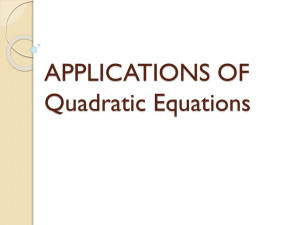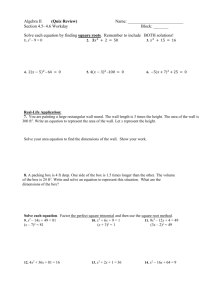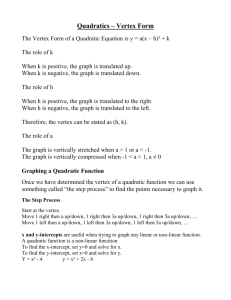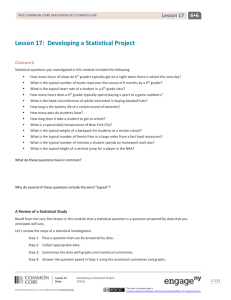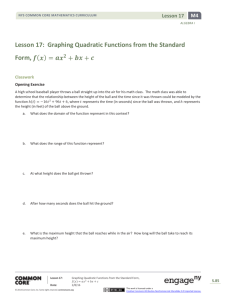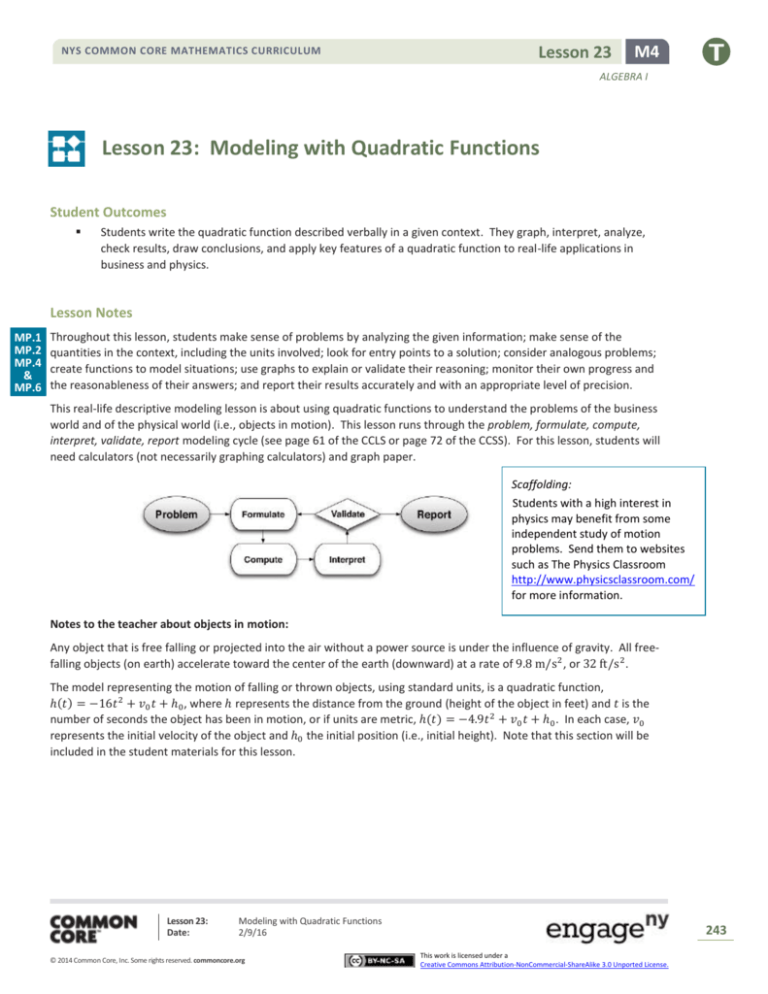
NYS COMMON CORE MATHEMATICS CURRICULUM
Lesson 23
M4
ALGEBRA I
Lesson 23: Modeling with Quadratic Functions
Student Outcomes
Students write the quadratic function described verbally in a given context. They graph, interpret, analyze,
check results, draw conclusions, and apply key features of a quadratic function to real-life applications in
business and physics.
Lesson Notes
MP.1
MP.2
MP.4
&
MP.6
Throughout this lesson, students make sense of problems by analyzing the given information; make sense of the
quantities in the context, including the units involved; look for entry points to a solution; consider analogous problems;
create functions to model situations; use graphs to explain or validate their reasoning; monitor their own progress and
the reasonableness of their answers; and report their results accurately and with an appropriate level of precision.
This real-life descriptive modeling lesson is about using quadratic functions to understand the problems of the business
world and of the physical world (i.e., objects in motion). This lesson runs through the problem, formulate, compute,
interpret, validate, report modeling cycle (see page 61 of the CCLS or page 72 of the CCSS). For this lesson, students will
need calculators (not necessarily graphing calculators) and graph paper.
Scaffolding:
Students with a high interest in
physics may benefit from some
independent study of motion
problems. Send them to websites
such as The Physics Classroom
http://www.physicsclassroom.com/
for more information.
Notes to the teacher about objects in motion:
Any object that is free falling or projected into the air without a power source is under the influence of gravity. All freefalling objects (on earth) accelerate toward the center of the earth (downward) at a rate of 9.8 m/s 2 , or 32 ft/s 2 .
The model representing the motion of falling or thrown objects, using standard units, is a quadratic function,
ℎ(𝑡) = −16𝑡 2 + 𝑣0 𝑡 + ℎ0 , where ℎ represents the distance from the ground (height of the object in feet) and 𝑡 is the
number of seconds the object has been in motion, or if units are metric, ℎ(𝑡) = −4.9𝑡 2 + 𝑣0 𝑡 + ℎ0 . In each case, 𝑣0
represents the initial velocity of the object and ℎ0 the initial position (i.e., initial height). Note that this section will be
included in the student materials for this lesson.
Lesson 23:
Date:
Modeling with Quadratic Functions
2/9/16
© 2014 Common Core, Inc. Some rights reserved. commoncore.org
243
This work is licensed under a
Creative Commons Attribution-NonCommercial-ShareAlike 3.0 Unported License.
Lesson 23
NYS COMMON CORE MATHEMATICS CURRICULUM
M4
ALGEBRA I
Classwork
Opening (5 minutes): The Mathematics of Objects in Motion
Opening: The Mathematics of Objects in Motion
Read the following explanation of the Mathematics of Objects in Motion:
Any object that is free falling or projected into the air without a power source is under the influence of gravity. All freefalling objects on earth accelerate toward the center of the earth (downward) at a constant rate (−𝟑𝟐 𝐟𝐭/𝐬 𝟐, or
−𝟗. 𝟖 𝐦/𝐬 𝟐) because of the constant force of earth’s gravity (represented by 𝒈). That acceleration rate is included in the
physics formula used for all objects in a free-falling motion. It represents the relationship of the height of the object
(distance from earth) with respect to the time that has passed since the launch or fall began. That formula is
𝟏
𝟐
𝒉(𝒕) = 𝒈𝒕𝟐 + 𝒗𝟎 𝒕 + 𝒉𝟎 .
For this reason, the leading coefficient for a quadratic function that models the position of a falling, launched, or
projected object must either be −𝟏𝟔 or −𝟒. 𝟗. Physicists use mathematics to make predictions about the outcome of a
falling or projected object.
The mathematical formulas (equations) used in physics commonly use certain variables to indicate quantities that are
most often used for motion problems. For example, the following are commonly used variables for an event that includes
an object that has been dropped or thrown:
𝒉 is often used to represent the function of height (how high the object is above earth in feet or meters);
𝒕 is used to represent the time (number of seconds) that have passed in the event;
𝒗 is used to represent velocity (the rate at which an object changes position in 𝐟𝐭/𝐬 or 𝐦/𝐬);
𝒔 is used to represent the object’s change in position, or displacement (how far the object has moved in feet or
meters).
We often use subscripts with the variables, partly so that we can use the same variables multiple times in a problem
without getting confused, but also to indicate the passage of time. For example:
𝒗𝟎 indicates the initial velocity (i.e., the velocity at 𝟎 seconds);
𝒉𝟎 tells us the height of the object at 𝟎 seconds, or the initial position.
So putting all of that together, we have a model representing the motion of falling or thrown objects, using U.S. standard
units, as a quadratic function:
𝒉(𝒕) = −𝟏𝟔𝒕𝟐 + 𝒗𝟎 𝒕 + 𝒉𝟎 ,
where 𝒉 represents the height of the object in feet (distance from the earth), and 𝒕 is the number of seconds the object
has been in motion. Note that the negative sign in front of the 𝟏𝟔 (half of 𝒈 = 𝟑𝟐) indicates the downward pull of
gravity. We are using a convention for quantities with direction here; upward is positive and downward is negative. If
units are metric, the following equation is used:
𝒉(𝒕) = −𝟒. 𝟗𝒕𝟐 + 𝒗𝟎 𝒕 + 𝒉𝟎 ,
where everything else is the same, but now the height of the object is measured in meters and the velocity in meters per
second.
These physics functions can be used to model many problems presented in the context of free-falling or projected objects
(objects in motion without any inhibiting or propelling power source, such as a parachute or an engine).
Lesson 23:
Date:
Modeling with Quadratic Functions
2/9/16
© 2014 Common Core, Inc. Some rights reserved. commoncore.org
244
This work is licensed under a
Creative Commons Attribution-NonCommercial-ShareAlike 3.0 Unported License.
Lesson 23
NYS COMMON CORE MATHEMATICS CURRICULUM
M4
ALGEBRA I
Mathematical Modeling Exercise 1 (15 minutes)
After students have read the explanation in the student materials of the physics of free-falling objects in motion, discuss
the variables and parameters used in the function to describe projectile motion on earth.
Provide graph paper for the following problem. Have students work in pairs or small groups; read the problem from the
student materials and discuss an entry point for answering the related questions. Then, walk students through the
problem-solving process using the guiding questions provided below.
Mathematical Modeling Exercise 1
Use the information in the Opening to answer the following questions.
Chris stands on the edge of a building at a height of 𝟔𝟎 𝐟𝐭. and throws a ball upward with an initial velocity of 𝟔𝟖 𝐟𝐭/𝐬.
The ball eventually falls all the way to the ground. What is the maximum height reached by the ball? After how many
seconds will the ball reach its maximum height? How long will it take the ball to reach the ground?
a.
What units will we be using to solve this problem?
Feet for height, seconds for time, and feet per second for velocity.
b.
What information from the contextual description do we need to use in the function
equation?
Gravity = −𝟑𝟐 𝐟𝐭/𝐬𝟐
Scaffolding:
Visual learners might benefit
from a graphing tool to see this
function’s graph. An online
tool can be found here:
www.desmos.com/calculator.
Initial Velocity (𝒗𝟎 )= 𝟔𝟖 𝐟𝐭/𝐬
Initial Height (𝒉𝟎 )= 𝟔𝟎 𝐟𝐭.
So, the function is 𝒉(𝒕) = −𝟏𝟔𝒕𝟐 + 𝟔𝟖𝒕 + 𝟔𝟎.
c.
What is the maximum point reached by the ball? After how many seconds will it reach that height? Show
your reasoning.
The maximum function value is at the vertex. To find this value, we first notice that this function is factorable
and is not particularly friendly for completing the square. So, we will rewrite the function in factored form,
𝒇(𝒕) = −𝟒(𝟒𝒕𝟐 − 𝟏𝟕𝒕 − 𝟏𝟓) 𝒇(𝒕) = −𝟒(𝟒𝒕 + 𝟑)(𝒕 − 𝟓).
Second, we find the zeros, or the 𝒙-intercepts, of the function by equating the function to zero (zero height).
So, −𝟒 (𝟒𝒕 + 𝟑)(𝒕 − 𝟓) = 𝟎.
Then, (𝟒𝒕 + 𝟑) = 𝟎 or (𝒕 − 𝟓) = 𝟎.
𝟑
𝟒
𝒕-intercepts are 𝒕 = − or 𝒕 = 𝟓.
Then, using the concept of symmetry, we find the midpoint of the segment connecting the two 𝒕-intercepts
(find the average of the 𝒕-coordinates): 𝒕 =
− 𝟑 +𝟓
𝟏
𝟒
= 𝟐 , or 𝟐. 𝟏𝟐𝟓.
𝟐
𝟖
Now, we find 𝒉(𝟐. 𝟏𝟐𝟓) in the original function, 𝒉(𝒕) = −𝟏𝟔𝒕𝟐 + 𝟔𝟖𝒕 + 𝟔𝟎, 𝒉(𝟐. 𝟏𝟐𝟓) = 𝟏𝟑𝟐. 𝟐𝟓
Therefore, the ball reached its maximum height of 𝟏𝟑𝟐. 𝟐𝟓 𝐟𝐭. after 𝟐. 𝟏𝟐𝟓 𝐬𝐞𝐜.
(Note that students may try to complete the square for this function. The calculations are very messy but the
results will be the same:
𝒉(𝒕) = −𝟏𝟔 (𝒕 −
𝟏𝟕 𝟐 𝟓𝟐𝟗
) +
= −𝟏𝟔(𝒕 − 𝟐. 𝟏𝟐𝟓)𝟐 + 𝟏𝟑𝟐. 𝟐𝟓. Students may also opt to use the vertex
𝟖
𝟒
formula.)
Lesson 23:
Date:
Modeling with Quadratic Functions
2/9/16
© 2014 Common Core, Inc. Some rights reserved. commoncore.org
245
This work is licensed under a
Creative Commons Attribution-NonCommercial-ShareAlike 3.0 Unported License.
Lesson 23
NYS COMMON CORE MATHEMATICS CURRICULUM
M4
ALGEBRA I
d.
How long will it take the ball to land on the ground after being thrown? Show your work.
We factored in the previous question and found the zeros of this function to be 𝒕 = −
𝟑
and 𝒕 = 𝟓. The ball
𝟒
begins its flight at 𝟎 𝐬𝐞𝐜. and ends at 𝟓 𝐬𝐞𝐜. Therefore, it will be in flight for 𝟓 𝐬𝐞𝐜.
e.
Graph the function of the height (𝒉) of the ball in feet to the time (𝒕) in seconds. Include and label key
features of the graph such as the vertex, axis of symmetry, and 𝒕- and 𝒚-intercepts.
The graph should include identification of the intercepts, vertex, and axis of symmetry.
Vertex: (𝟐. 𝟏𝟐𝟓, 𝟏𝟑𝟐. 𝟐𝟓)
𝒕-intercepts: (−𝟎. 𝟕𝟓, 𝟎) and (𝟓, 𝟎)
𝒚-intercept: (𝟎, 𝟔𝟎) (See graph of 𝒚 = 𝒉(𝒕))
Vertex (2.125, 132.25)
Axis of symmetry: 𝑡 = 2.125
(0, 60)
−
3
,0
4
(5, 0)
Mathematical Modeling Exercise 2 (10 minutes)
Have students review the terminology for business applications and read the context of the problem. Discuss the
quantities in the problem and the entry point for solving the problem. Then, solve the problem below. Walk them
through the steps to solve the problem using the guiding questions and commentary provided.
Notes to the teacher about business applications:
The following business formulas will be used in business applications in this module. Refer your students to Lesson 12 if
they need a more detailed review.
Total Production Cost = (cost per item)(total number of items sold)
Total Revenue = (price per item)(total number of items sold)
Profit = Total Revenue − Total Production Cost
Lesson 23:
Date:
Modeling with Quadratic Functions
2/9/16
© 2014 Common Core, Inc. Some rights reserved. commoncore.org
246
This work is licensed under a
Creative Commons Attribution-NonCommercial-ShareAlike 3.0 Unported License.
Lesson 23
NYS COMMON CORE MATHEMATICS CURRICULUM
M4
ALGEBRA I
Mathematical Modeling Exercise 2
Read the following information about Business Applications:
Many business contexts can be modeled with quadratic functions. This is because the expressions representing price
(price per item), the cost (cost per item), and the quantity (number of items sold) are typically linear. The product of any
two of those linear expressions will produce a quadratic expression that can be used as a model for the business context.
The variables used in business applications are not as traditionally accepted as variables that are used in physics
applications, but there are some obvious reasons to use 𝒄 for cost, 𝒑 for price, and 𝒒 for quantity (all lowercase letters).
For total production cost we often use 𝑪 for the variable, 𝑹 for total revenue, and 𝑷 for total profit (all uppercase letters).
You have seen these formulas in previous lessons, but we will review them here since we use them in the next two
lessons.
Business Application Vocabulary
UNIT PRICE (PRICE PER UNIT): The price per item a business sets to sell its product, sometimes represented as a linear
expression.
QUANTITY: The number of items sold, sometimes represented as a linear expression.
REVENUE: The total income based on sales (but without considering the cost of doing business).
UNIT COST (COST PER UNIT) OR PRODUCTION COST: The cost of producing one item, sometimes represented as a linear
expression.
PROFIT: The amount of money a business makes on the sale of its product. Profit is determined by taking the total
revenue (the quantity sold multiplied by the price per unit) and subtracting the total cost to produce the items (the
quantity sold multiplied by the production cost per unit): 𝐏𝐫𝐨𝐟𝐢𝐭 = 𝐓𝐨𝐭𝐚𝐥 𝐑𝐞𝐯𝐞𝐧𝐮𝐞 − 𝐓𝐨𝐭𝐚𝐥 𝐏𝐫𝐨𝐝𝐮𝐜𝐭𝐢𝐨𝐧 𝐂𝐨𝐬𝐭.
The following business formulas will be used in this lesson:
𝐓𝐨𝐭𝐚𝐥 𝐏𝐫𝐨𝐝𝐮𝐜𝐭𝐢𝐨𝐧 𝐂𝐨𝐬𝐭𝐬 = (𝐜𝐨𝐬𝐭 𝐩𝐞𝐫 𝐮𝐧𝐢𝐭)(𝐪𝐮𝐚𝐧𝐭𝐢𝐭𝐲 𝐨𝐟 𝐢𝐭𝐞𝐦𝐬 𝐬𝐨𝐥𝐝)
𝐓𝐨𝐭𝐚𝐥 𝐑𝐞𝐯𝐞𝐧𝐮𝐞 = (𝐩𝐫𝐢𝐜𝐞 𝐩𝐞𝐫 𝐮𝐧𝐢𝐭)(𝐪𝐮𝐚𝐧𝐭𝐢𝐭𝐲 𝐨𝐟 𝐢𝐭𝐞𝐦𝐬 𝐬𝐨𝐥𝐝)
𝐏𝐫𝐨𝐟𝐢𝐭 = 𝐓𝐨𝐭𝐚𝐥 𝐑𝐞𝐯𝐞𝐧𝐮𝐞 − 𝐓𝐨𝐭𝐚𝐥 𝐏𝐫𝐨𝐝𝐮𝐜𝐭𝐢𝐨𝐧 𝐂𝐨𝐬𝐭𝐬
Now answer the questions related to the following business problem:
A theater decided to sell special event tickets at $𝟏𝟎 per ticket to benefit a local charity. The theater can seat up to
𝟏, 𝟎𝟎𝟎 people and the manager of the theater expects to be able to sell all 𝟏, 𝟎𝟎𝟎 seats for the event. To maximize the
revenue for this event, a research company volunteered to do a survey to find out whether the price of the ticket could be
increased without losing revenue. The results showed that for each $𝟏 increase in ticket price, 𝟐𝟎 fewer tickets will be
sold.
a.
Let 𝒙 represent the number of $𝟏. 𝟎𝟎 price-per-ticket increases. Write an expression to represent the
expected price for each ticket.
Let 𝒙 = number of $𝟏 increases. If each ticket is $𝟏𝟎, plus a possible price increase in $𝟏 increments, the price
per ticket will be $𝟏𝟎 + $𝟏(𝒙) = 𝟏𝟎 + 𝟏𝒙.
Price per ticket = 𝟏𝟎 + 𝒙
b.
Use the survey results to write an expression representing the possible number of tickets sold.
Since 𝟐𝟎 fewer seats will be sold for each $𝟏 increase in the ticket price, 𝟐𝟎𝒙 represents the number of seats
fewer than 𝟏, 𝟎𝟎𝟎 that will be sold.
𝟏, 𝟎𝟎𝟎 − 𝟐𝟎𝒙 is the expected number of tickets sold at this higher price.
Lesson 23:
Date:
Modeling with Quadratic Functions
2/9/16
© 2014 Common Core, Inc. Some rights reserved. commoncore.org
247
This work is licensed under a
Creative Commons Attribution-NonCommercial-ShareAlike 3.0 Unported License.
Lesson 23
NYS COMMON CORE MATHEMATICS CURRICULUM
M4
ALGEBRA I
Point out that if there are no price increases, we would expect to sell all 1,000 seats (𝑥 = 0), but there will be 20 fewer
for each $1.00 in price-per-ticket increase.
c.
Using 𝒙 as the number of $𝟏-ticket price increases and the expression representing price per ticket, write the
function, 𝑹, to represent the total revenue in terms of the number of $𝟏-ticket price increases.
𝐓𝐨𝐭𝐚𝐥 𝐑𝐞𝐯𝐞𝐧𝐮𝐞 = (𝐩𝐫𝐢𝐜𝐞 𝐩𝐞𝐫 𝐭𝐢𝐜𝐤𝐞𝐭)(𝐧𝐮𝐦𝐛𝐞𝐫 𝐨𝐟 𝐭𝐢𝐜𝐤𝐞𝐭𝐬)
𝑹(𝒙) = (𝟏, 𝟎𝟎𝟎 − 𝟐𝟎𝒙)(𝟏𝟎 + 𝒙) = 𝟏𝟎, 𝟎𝟎𝟎 + 𝟏, 𝟎𝟎𝟎𝒙 − 𝟐𝟎𝟎𝒙 − 𝟐𝟎𝒙𝟐 = −𝟐𝟎𝒙𝟐 + 𝟖𝟎𝟎𝒙 + 𝟏𝟎, 𝟎𝟎𝟎
Point out that quadratic expressions are usually written in standard form with exponents in descending order. However,
there is no requirement to do so, and students would be equally correct to leave the equation in factored form.
d.
How many $𝟏-ticket price increases will produce the maximum revenue? (In other words, what value for 𝒙
produces the maximum 𝑹 value?)
We need to find the vertex of the revenue equation. The equation is originally in factored form, so we can just
go back to that form, or we can complete the square (which seems to be pretty efficient).
1.
By completing the square: 𝑹(𝒙) = −𝟐𝟎(𝒙𝟐 − 𝟒𝟎𝒙 + ___) + 𝟏𝟎, 𝟎𝟎𝟎
−𝟐𝟎(𝒙𝟐 − 𝟒𝟎𝒙 + 𝟒𝟎𝟎) + 𝟏𝟎, 𝟎𝟎𝟎 + 𝟖𝟎𝟎𝟎
−𝟐𝟎(𝒙 − 𝟐𝟎)𝟐 + 𝟏𝟖, 𝟎𝟎𝟎, so the vertex is (𝟐𝟎, 𝟏𝟖𝟎𝟎𝟎).
2.
Using the factors, set the equation equal to zero to find the zeros of the function:
𝑹(𝒙) = (𝟏, 𝟎𝟎𝟎 − 𝟐𝟎𝒙)(𝟏𝟎 + 𝒙) = 𝟎
𝒙 = −𝟏𝟎 and 𝟓𝟎 are the zeros, and the vertex will be on the axis of symmetry (at the midpoint between
−𝟏𝟎 and 𝟓𝟎), which is 𝒙 = 𝟐𝟎.
Finally, we reach the conclusion that after 𝟐𝟎 price increases, the theater will maximize its revenue.
e.
What is the price of the ticket that will provide the maximum revenue?
Price per ticket expression is 𝟏𝟎 + 𝒙, so the price will be $𝟏𝟎 + $𝟐𝟎 = $𝟑𝟎.
f.
What is the maximum revenue?
According to the 𝑹-value at the vertex, the maximum revenue will be $𝟏𝟖, 𝟎𝟎𝟎.
g.
How many tickets will the theater sell to reach the maximum revenue?
With the maximum revenue of $𝟏𝟖, 𝟎𝟎𝟎 at $𝟑𝟎/ticket, the theater is selling 𝟔𝟎𝟎 tickets.
h.
How much more will the theater make for the charity by using the results of the survey to price the tickets
than they would had they sold the tickets for their original $𝟏𝟎 price?
At $𝟏𝟎 per ticket, the theater would have brought in $𝟏𝟎, 𝟎𝟎𝟎 after selling all 𝟏, 𝟎𝟎𝟎 seats. The theater will
make an additional $𝟖, 𝟎𝟎𝟎 by using the survey results to price their tickets.
Lesson 23:
Date:
Modeling with Quadratic Functions
2/9/16
© 2014 Common Core, Inc. Some rights reserved. commoncore.org
248
This work is licensed under a
Creative Commons Attribution-NonCommercial-ShareAlike 3.0 Unported License.
Lesson 23
NYS COMMON CORE MATHEMATICS CURRICULUM
M4
ALGEBRA I
The next two exercises may be completed in class (if time permits) or added to the Problem Set. Working in pairs or
small groups, have students strategize entry points to the solutions and the necessary problem-solving process. They
should finish as much as possible in about 5 minutes for each exercise. Set a 5-minute timer after the start of Exercise 1
and again for Exercise 2. Remind them to refer to the two examples just completed if they get stuck. They should not
think that they can finish the tasks in the 5-minute time but should get a good start. What they do not finish in class,
should be completed as part of the Problem Set.
Exercise 1 (5 minutes)
Use a timer and start on Exercise 2 after 5 minutes.
Exercise 1
Two rock climbers try an experiment while scaling a steep rock face. They each carry rocks of similar size and shape up a
rock face. One climbs to a point 𝟒𝟎𝟎 𝐟𝐭. above the ground, and the other climbs to a place below her at 𝟑𝟎𝟎 𝐟𝐭. above the
ground. The higher climber drops her rock, and 𝟏 second later the lower climber drops his. Note that the climbers are not
vertically positioned. No climber is injured in this experiment.
a.
Define the variables in this situation, and write the two functions that can be used to model the relationship
between the heights, 𝒉𝟏 and 𝒉𝟐 , of the rocks, in feet, after 𝒕 seconds.
𝒉𝟏 represents the height of the rock dropped by the higher climber,
𝒉𝟐 represents the height of the rock dropped by the lower climber,
𝒕 represents the number of seconds passed since the higher climber dropped her rock,
𝒕 − 𝟏 represents the number of seconds since the lower climber dropped his rock.
𝒉𝟏 (𝒕) = −𝟏𝟔𝒕𝟐 + 𝟒𝟎𝟎 and 𝒉𝟐 (𝒕) = −𝟏𝟔(𝒕 − 𝟏)𝟐 + 𝟑𝟎𝟎
b.
Assuming the rocks fall to the ground without hitting anything on the way, which of the two rocks will reach
the ground last? Show your work, and explain how you know your answer is correct.
We are looking for the zeros in this case. Setting each function equal to zero we get:
𝒉𝟏 (𝒕) = −𝟏𝟔𝒕𝟐 + 𝟒𝟎𝟎 = 𝟎
−𝟏𝟔(𝒕 − 𝟐𝟓) = 𝟎
−𝟏𝟔(𝒕 + 𝟓)(𝒕 − 𝟓) = 𝟎
𝒕 = −𝟓 or 𝟓 𝒔𝒆𝒄𝒐𝒏𝒅𝒔
𝟐
For this context, it will take 𝟓 𝐬𝐞𝐜𝐨𝐧𝐝𝐬 for the higher climber’s rock to hit the ground.
𝒉𝟐 (𝒕) = −𝟏𝟔(𝒕 − 𝟏)𝟐 + 𝟑𝟎𝟎 = 𝟎 The standard form for this equation is 𝒉𝟐 (𝒕) = −𝟏𝟔𝒕𝟐 + 𝟑𝟐𝒕 + 𝟐𝟖𝟒, which
is not factorable. We will solve from the completed-square form.
−𝟏𝟔(𝒕 − 𝟏)𝟐 + 𝟑𝟎𝟎 = 𝟎
−𝟏𝟔(𝒕 − 𝟏)𝟐 = −𝟑𝟎𝟎
(𝒕 − 𝟏)𝟐 =
𝟑𝟎𝟎
[square root both sides]
𝟏𝟔
𝒕−𝟏 = ±
√𝟑𝟎𝟎
𝟒
𝒕 = 𝟏 ±
√𝟑𝟎𝟎
𝟒
≈ approximately −𝟑. 𝟑 or 𝟓. 𝟑
For this context, it will take 𝟓. 𝟑 𝐬𝐞𝐜𝐨𝐧𝐝𝐬 for the lower climber's rock to hit the ground.
The rock dropped from the higher position will hit the ground approximately 𝟎. 𝟑 𝐬𝐞𝐜𝐨𝐧𝐝𝐬 before the rock
dropped from the lower position. (Notice that the first function equation is easy to factor, but the other is not.
Students may try to factor but may use the completed-square form to solve or may opt to use the quadratic
formula on the second one.)
Lesson 23:
Date:
Modeling with Quadratic Functions
2/9/16
© 2014 Common Core, Inc. Some rights reserved. commoncore.org
249
This work is licensed under a
Creative Commons Attribution-NonCommercial-ShareAlike 3.0 Unported License.
Lesson 23
NYS COMMON CORE MATHEMATICS CURRICULUM
M4
ALGEBRA I
c.
Graph the two functions on the same coordinate plane, and identify the key features that show that your
answer to part (b) is correct. Explain how the graphs show that the two rocks hit the ground at different
times.
The two times are indicated on the 𝒙-axis as the 𝒙-intercepts. The red graph shows the height-to-time
relationship for the rock dropped from 𝟑𝟎𝟎 𝐟𝐭., and the blue graph shows the same for the rock dropped from
𝟒𝟎𝟎 𝐟𝐭. For the red graph, 𝒉(𝒕) = 𝟎 when 𝒕 = 𝟓. 𝟑, and for the blue graph, 𝒉(𝒕) = 𝟎 when 𝒕 = 𝟓.
d.
Does the graph show how far apart the rocks were when they landed? Explain.
No, the graph only shows the height of the rocks with respect to time. Horizontal position and movement are
not indicated in the function or the graph.
Exercise 2 (5 minutes)
Use a timer and start on the Exit Ticket after 5 minutes.
Exercise 2
Amazing Photography Studio takes school pictures and charges $𝟐𝟎 for each class picture. The company sells an average
of 𝟏𝟐 class pictures in each classroom. They would like to have a special sale that will help them sell more pictures and
actually increase their revenue. They hired a business analyst to determine how to do that. The analyst determined that
for every reduction of $𝟐 in the cost of the class picture, there would be an additional 𝟓 pictures sold per classroom.
a.
Write a function to represent the revenue for each classroom for the special sale.
Let 𝒙 represent the number of $𝟐 reductions in price.
Then the price expression would be $𝟐𝟎 − $𝟐(𝒙) = 𝟐𝟎 − 𝟐𝒙.
The quantity expression would be 𝟏𝟐 + 𝟓𝒙.
So, the revenue is 𝑹(𝒙) = (𝟐𝟎 − 𝟐𝒙)(𝟏𝟐 + 𝟓𝒙) = 𝟐𝟒𝟎 + 𝟏𝟎𝟎𝒙 − 𝟐𝟒𝒙 − 𝟏𝟎𝒙𝟐 = −𝟏𝟎𝒙𝟐 + 𝟕𝟔𝒙 + 𝟐𝟒𝟎.
Lesson 23:
Date:
Modeling with Quadratic Functions
2/9/16
© 2014 Common Core, Inc. Some rights reserved. commoncore.org
250
This work is licensed under a
Creative Commons Attribution-NonCommercial-ShareAlike 3.0 Unported License.
Lesson 23
NYS COMMON CORE MATHEMATICS CURRICULUM
M4
ALGEBRA I
b.
What should the special sale price be?
Find the vertex for 𝑹(𝒙) = −𝟏𝟎𝒙𝟐 + 𝟕𝟔𝒙 + 𝟐𝟒𝟎.
−𝟏𝟎(𝒙𝟐 − 𝟕. 𝟔𝒙 + ____) + 𝟐𝟒𝟎
−𝟏𝟎(𝒙𝟐 − 𝟕. 𝟔𝒙 + 𝟑. 𝟖𝟐 ) + 𝟐𝟒𝟎 + 𝟑. 𝟖𝟐 (𝟏𝟎) = −𝟏𝟎(𝒙 − 𝟑. 𝟖)𝟐 + 𝟐𝟒𝟎 + 𝟏𝟒𝟒. 𝟒𝟎
So, 𝑹(𝒙) = −𝟏𝟎(𝒙 − 𝟑. 𝟖)𝟐 + 𝟑𝟖𝟒. 𝟒, and the studio should reduce the price by between three or four $𝟐increments.
If we check the revenue amount for 𝟑 reductions, the price is $𝟐𝟎 − $𝟐(𝟑) = $𝟏𝟒. The quantity will be 𝟏𝟐 +
𝟓(𝟑) = 𝟐𝟕 pictures per classroom, so the revenue would be $𝟑𝟕𝟖.
Now check 𝟒 reductions: The price is $𝟐𝟎 − $𝟐(𝟒) = $𝟏𝟐. The quantity will be 𝟏𝟐 + 𝟓(𝟒) = 𝟑𝟐 pictures per
classroom, and the revenue for 𝟒 reductions would be $𝟑𝟖𝟒.
The special sale price should be $𝟏𝟐 since the revenue was greater than when the price was $𝟏𝟒.
c.
How much more will the studio make than they would have without the sale?
The revenue for each class will be $𝟑𝟖𝟒 during the sale. They would make $𝟐𝟎 per picture for 𝟏𝟐 pictures, or
$𝟐𝟒𝟎. They will increase their revenue by $𝟏𝟒𝟒 per classroom.
To ensure students understand, have them look at the revenue for five $2-increments of price reduction. The price
expression is 20 − 2(5) = $10. The quantity will be 12 + 5(5) = 37. That makes the revenue for five $2-increments in
price reduction $370. The revenue is going back down. Are you surprised?
Closing (1 minute)
Lesson Summary
We can write quadratic functions described verbally in a given context. We can also graph, interpret, analyze, or
apply key features of quadratic functions to draw conclusions that help us answer questions taken from the
problem’s context.
We find quadratic functions commonly applied in physics and business.
We can substitute known 𝒙- and 𝒚-values into a quadratic function to create a linear system that, when
solved, can identify the parameters of the quadratic equation representing the function.
Exit Ticket (4 minutes)
Lesson 23:
Date:
Modeling with Quadratic Functions
2/9/16
© 2014 Common Core, Inc. Some rights reserved. commoncore.org
251
This work is licensed under a
Creative Commons Attribution-NonCommercial-ShareAlike 3.0 Unported License.
Lesson 23
NYS COMMON CORE MATHEMATICS CURRICULUM
M4
ALGEBRA I
Name ___________________________________________________
Date____________________
Lesson 23: Modeling with Quadratic Functions
Exit Ticket
What is the relevance of the vertex in physics and business applications?
Lesson 23:
Date:
Modeling with Quadratic Functions
2/9/16
© 2014 Common Core, Inc. Some rights reserved. commoncore.org
252
This work is licensed under a
Creative Commons Attribution-NonCommercial-ShareAlike 3.0 Unported License.
Lesson 23
NYS COMMON CORE MATHEMATICS CURRICULUM
M4
ALGEBRA I
Exit Ticket Sample Solutions
What is the relevance of the vertex in physics and business applications?
By finding the vertex, we know the highest or lowest value for the function and also the 𝒙-value that gives that minimum
or maximum. In physics, that could mean the highest point for an object in motion. In business, that could mean the
minimum cost or the maximum profit or revenue.
Problem Set Sample Solutions
1.
Dave throws a ball upward with an initial velocity of 𝟑𝟐 𝐟𝐭/𝐬. The ball initially leaves his hand 𝟓 𝐟𝐭. above the
ground and eventually falls back to the ground. In parts (a)–(d), you will answer the following questions: What is
the maximum height reached by the ball? After how many seconds will the ball reach its maximum height? How
long will it take the ball to reach the ground?
a.
What units will we be using to solve this problem?
Height is measured in feet, time is measured in seconds, and velocity is measured in feet per second.
b.
What information from the contextual description do we need to use to write the formula for the function 𝒉
of the height of the ball versus time? Write the formula for height of the ball in feet, 𝒉(𝒕), where 𝒕 stands for
seconds.
Gravity: −𝟑𝟐 𝐟𝐭/𝐬𝟐
Initial height (𝒉𝟎 ): 𝟓 𝐟𝐭. above the ground
Initial velocity (𝒗𝟎 ): 𝟑𝟐 𝐟𝐭/𝐬
Function: 𝒉(𝒕) = −𝟏𝟔𝒕𝟐 + 𝟑𝟐𝒕 + 𝟓
c.
What is the maximum point reached by the ball? After how many seconds will it reach that height? Show
your reasoning.
Complete the square:
𝒉(𝒕) = −𝟏𝟔𝒕𝟐 + 𝟑𝟐𝒕 + 𝟓
𝒉(𝒕) = −𝟏𝟔(𝒕𝟐 − 𝟐𝒕 +
𝟐
)+𝟓+
𝒉(𝒕) = −𝟏𝟔(𝒕 − 𝟐𝒕 + 𝟏) + 𝟓 + 𝟏𝟔
𝟐
𝒉(𝒕) = −𝟏𝟔(𝒕 − 𝟏) + 𝟐𝟏
Lesson 23:
Date:
Completing the square
The vertex (maximum height) is 𝟐𝟏 𝐟𝐭. and is reached at 𝟏 𝐬𝐞𝐜.
Modeling with Quadratic Functions
2/9/16
© 2014 Common Core, Inc. Some rights reserved. commoncore.org
253
This work is licensed under a
Creative Commons Attribution-NonCommercial-ShareAlike 3.0 Unported License.
Lesson 23
NYS COMMON CORE MATHEMATICS CURRICULUM
M4
ALGEBRA I
d.
How long will it take for the ball to land on the ground after being thrown? Show your work.
The ball will land at a time 𝒕 when 𝒉(𝒕) = 𝟎, that is, when 𝟎 = −𝟏𝟔𝒕𝟐 + 𝟑𝟐𝒕 + 𝟓:
𝟎 = −𝟏𝟔 𝒕𝟐 − 𝟐𝒕 −
𝟓
𝟏𝟔
𝒕=
−𝒃 ± √𝒃𝟐 − 𝟒𝒂𝒄
𝟐𝒂
−(−𝟐) ± √(−𝟐)𝟐 − 𝟒(𝟏) (−
𝒕=
𝟓
)
𝟏𝟔
𝟐(𝟏)
𝟐𝟎
𝟐 ± √𝟒 +
𝟏𝟔
𝒕=
𝟐
𝟐𝟏
𝟐±√
𝟒
𝒕=
𝟐
√𝟐𝟏
𝟒
𝒕 ≈ 𝟐. 𝟏𝟒𝟔 and 𝒕 ≈ −𝟎. 𝟏𝟒𝟔
𝒕=𝟏±
The negative value does not make sense in the context of the problem, so the ball reaches the ground in
approximately 𝟐. 𝟏 𝐬𝐞𝐜.
e.
Graph the function of the height of the ball in feet to the time in seconds. Include and label key features of
the graph such as the vertex, axis of symmetry, and 𝒙- and 𝒚-intercepts.
[Graph]
Vertex (maximum height)
Graph of 𝒉
𝒚-intercept (initial height)
Axis of
symmetry
𝒕=𝟏
𝒕-intercept (time at which
the ball hits the ground)
Lesson 23:
Date:
Modeling with Quadratic Functions
2/9/16
© 2014 Common Core, Inc. Some rights reserved. commoncore.org
254
This work is licensed under a
Creative Commons Attribution-NonCommercial-ShareAlike 3.0 Unported License.
Lesson 23
NYS COMMON CORE MATHEMATICS CURRICULUM
M4
ALGEBRA I
2.
Katrina developed an app that she sells for $𝟓 per download. She has free space on a website that will let her sell
𝟓𝟎𝟎 downloads. According to some research she did, for each $𝟏 increase in download price, 𝟏𝟎 fewer apps are
sold. Determine the price that will maximize her profit.
Profit equals total revenue minus total production costs. Since the website that Katrina is using allows up to 𝟓𝟎𝟎
downloads for free, there is no production cost involved, so the total revenue is the total profit.
Let 𝒙 represent the number of $𝟏 increases to the cost of a download.
Cost per download:
𝟓 + 𝟏𝒙
Apps sold:
𝟓𝟎𝟎 − 𝟏𝟎𝒙
𝐑𝐞𝐯𝐞𝐧𝐮𝐞 = (𝐮𝐧𝐢𝐭 𝐩𝐫𝐢𝐜𝐞)(𝐪𝐮𝐚𝐧𝐭𝐢𝐭𝐲 𝐬𝐨𝐥𝐝)
𝑹(𝒙) = (𝟓 + 𝟏𝒙)(𝟓𝟎𝟎 − 𝟏𝟎𝒙)
𝟎 = (𝟓 + 𝟏𝒙)(𝟓𝟎𝟎 − 𝟏𝟎𝒙)
𝟎= 𝟓+𝒙
or
𝟎 = 𝟓𝟎𝟎 − 𝟏𝟎𝒙
𝒙 = −𝟓
or
𝒙 = 𝟓𝟎
The average of the zeros represents the axis of symmetry.
−𝟓+𝟓𝟎
𝟐
= 𝟐𝟐. 𝟓
Katrina should raise the cost by $𝟐𝟐. 𝟓𝟎 to earn the greatest revenue.
𝑹(𝒙) = (𝟓 + 𝒙)(𝟓𝟎𝟎 − 𝟏𝟎𝒙)
𝑹(𝒙) = −𝟏𝟎𝒙𝟐 + 𝟒𝟓𝟎𝒙 + 𝟐𝟓𝟎𝟎
Written in standard form
𝑹(𝟐𝟐. 𝟓) = −𝟏𝟎(𝟐𝟐. 𝟓)𝟐 + 𝟒𝟓𝟎(𝟐𝟐. 𝟓) + 𝟐𝟓𝟎𝟎
𝑹(𝟐𝟐. 𝟓) = 𝟕𝟓𝟔𝟐. 𝟓𝟎
Katrina will maximize her profit if she increases the price per download by $𝟐𝟐. 𝟓𝟎 to $𝟐𝟕. 𝟓𝟎 per download. Her
total revenue (and profit) for each case would be $𝟕, 𝟓𝟔𝟐. 𝟓𝟎.
3.
Edward is drawing rectangles such that the sum of the length and width is always six inches.
a.
Draw one of Edward’s rectangles, and label the length and width.
𝟒 𝐢𝐧.
𝟐 𝐢𝐧.
b.
c.
Fill in the following table with four different possible lengths and widths.
Width (inches)
Length (inches)
𝟏
𝟓
𝟐
𝟒
𝟑
𝟑
𝟐. 𝟓
𝟑. 𝟓
Let 𝒙 be the width. Write an expression to represent the length of one of Edward’s rectangles.
If 𝒙 represents the width, then the length of the rectangle would be 𝟔 − 𝒙.
Lesson 23:
Date:
Modeling with Quadratic Functions
2/9/16
© 2014 Common Core, Inc. Some rights reserved. commoncore.org
255
This work is licensed under a
Creative Commons Attribution-NonCommercial-ShareAlike 3.0 Unported License.
Lesson 23
NYS COMMON CORE MATHEMATICS CURRICULUM
M4
ALGEBRA I
d.
Write an equation that gives the area, 𝒚, in terms of the width, 𝒙.
𝐀𝐫𝐞𝐚 = 𝐥𝐞𝐧𝐠𝐭𝐡 × 𝐰𝐢𝐝𝐭𝐡
𝒚 = 𝒙(𝟔 − 𝒙)
e.
For what width and length will the rectangle have maximum area?
𝒚 = 𝒙(𝟔 − 𝒙)
𝒚 = −𝒙𝟐 + 𝟔𝒙
𝒚 = −𝟏(𝒙𝟐 − 𝟔𝒙 +
)+
𝒚 = −𝟏(𝒙𝟐 − 𝟔𝒙 + 𝟗) + 𝟗
𝟐
𝒚 = −𝟏(𝒙 − 𝟑) + 𝟗
By completing the square
The vertex is (𝟑, 𝟗).
The rectangle with the maximum area has a width of 𝟑 𝐢𝐧. (also length 𝟑 𝐢𝐧.) and an area of 𝟗 𝐢𝐧𝟐 .
f.
Are you surprised by the answer to part (e)? What special name is given for the rectangle in your answer to
part (e)?
Responses will vary. The special rectangle in part (e) is a square.
Lesson 23:
Date:
Modeling with Quadratic Functions
2/9/16
© 2014 Common Core, Inc. Some rights reserved. commoncore.org
256
This work is licensed under a
Creative Commons Attribution-NonCommercial-ShareAlike 3.0 Unported License.
Lesson 23
NYS COMMON CORE MATHEMATICS CURRICULUM
M4
ALGEBRA I
4.
Chase is standing at the base of a 𝟔𝟎-foot cliff. He throws a rock in the air hoping to get the rock to the top of the
cliff. If the rock leaves his hand 𝟔 𝐟𝐭. above the base at a velocity of 𝟖𝟎 𝐟𝐭/𝐬, does the rock get high enough to reach
the top of the cliff? How do you know? If so, how long does it take the rock to land on top of the cliff (assuming it
lands on the cliff)? Graph the function, and label the key features of the graph.
I will consider the top of the cliff as 𝟎 𝐟𝐭. so that I can find the time when the rock lands by finding the zeros of the
function. Since Chase is standing at the bottom of the cliff, his initial height is negative; therefore, the initial height
of the rock is negative.
Gravity:
−𝟑𝟐 𝐟𝐭/𝐬 𝟐
Initial height: −𝟓𝟒 𝐟𝐭.
Initial velocity: 𝟖𝟎 𝐟𝐭/𝐬
𝒉(𝒕) = −𝟏𝟔𝒕𝟐 + 𝟖𝟎𝒕 − 𝟓𝟒
𝒉(𝒕) = −𝟏𝟔(𝒕𝟐 − 𝟓𝒕 +
) − 𝟓𝟒 +
𝟏
𝒉(𝒕) = −𝟏𝟔 (𝒕𝟐 − 𝟓𝒕 + 𝟔 ) − 𝟓𝟒 + 𝟏𝟎𝟎
𝟒
𝟓
𝟐
By completing the square
𝟐
𝒉(𝒕) = −𝟏𝟔 (𝒕 − ) + 𝟒𝟔
𝟓
𝟐
In completed square form, the vertex of the function is ( , 𝟒𝟔).
The rock reaches the top of the cliff because it reaches a maximum height
𝟏
𝟐
of 𝟒𝟔 𝐟𝐭. above the cliff at 𝟐 𝐬𝐞𝐜. after the rock was thrown.
To find how much time it takes to reach the top of the cliff, I found the
zeros of the function. I can see by the graph that the function has two
possible zeros; however, given the context of the problem, only the latter
of the two makes sense because the rock must go beyond the top of the
cliff in order to land on the top of the cliff.
𝒉(𝒕) = −𝟏𝟔𝒕𝟐 + 𝟖𝟎𝒕 − 𝟓𝟒
𝒉(𝒕) = −𝟐(𝟖𝒕𝟐 − 𝟒𝟎𝒕 + 𝟐𝟕)
𝒕=
−𝒃 ± √𝒃𝟐 − 𝟒𝒂𝒄
𝟐𝒂
𝒕=
−(−𝟒𝟎) ± √(−𝟒𝟎)𝟐 − 𝟒(𝟖)(𝟐𝟕)
𝟐(𝟖)
𝒕=
𝟒𝟎 ± √𝟏𝟔𝟎𝟎 − 𝟖𝟔𝟒
𝟏𝟔
𝟓 √𝟒𝟔
±
𝟐
𝟒
𝒕 ≈ 𝟎. 𝟖𝟎𝟒 or 𝒕 ≈ 𝟒. 𝟏𝟗𝟔
𝒕=
The rock lands on the top of the cliff at approximately 𝟒. 𝟐 𝐬𝐞𝐜. after it was thrown.
Lesson 23:
Date:
Modeling with Quadratic Functions
2/9/16
© 2014 Common Core, Inc. Some rights reserved. commoncore.org
257
This work is licensed under a
Creative Commons Attribution-NonCommercial-ShareAlike 3.0 Unported License.



